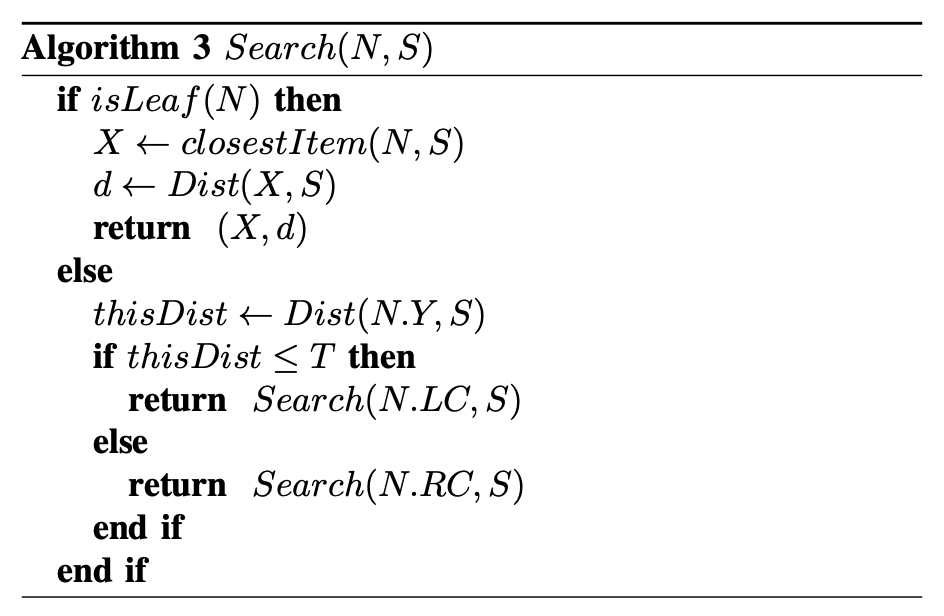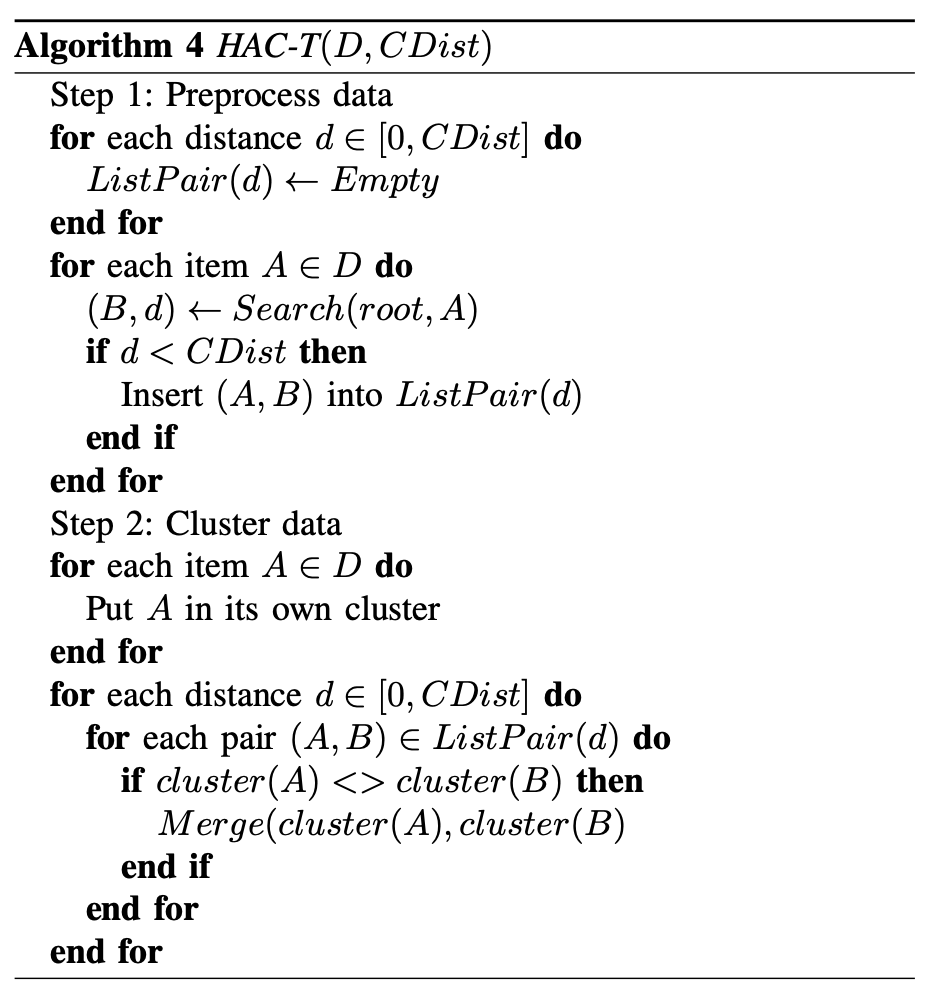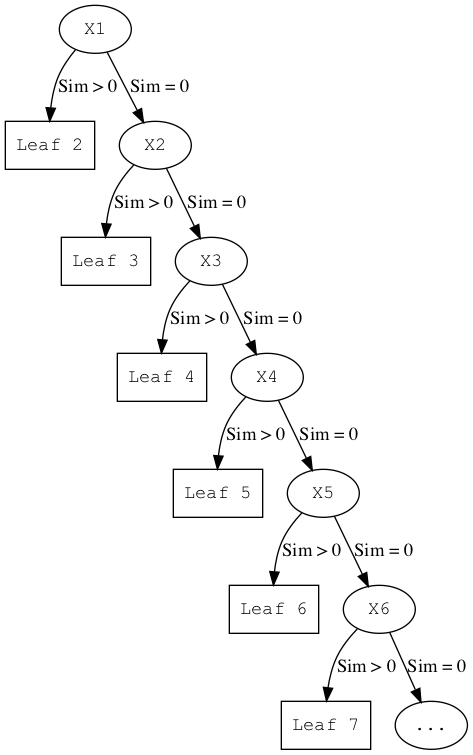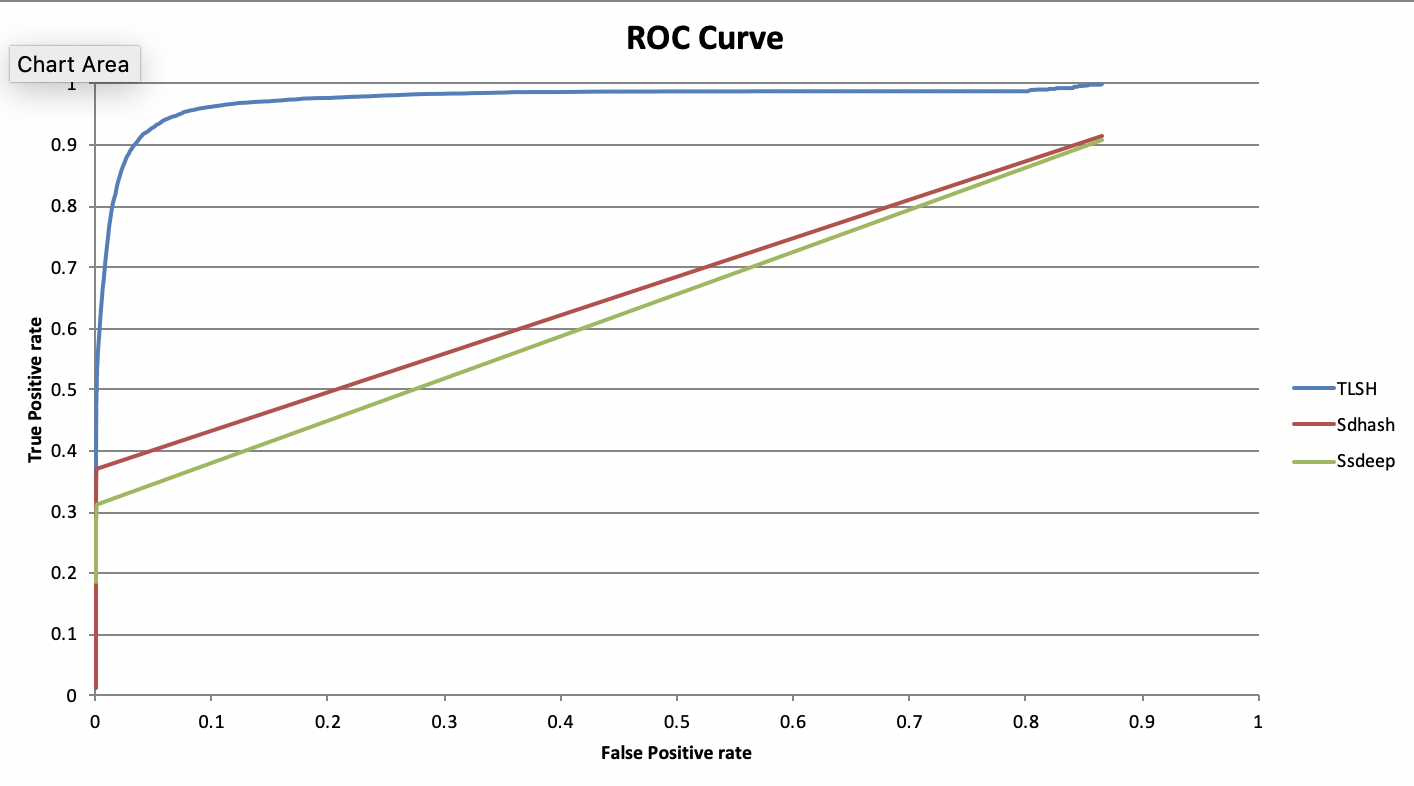12 / April / 2021.
Introduction
Intended Audience
In this page, we explain the technical details behind TLSH. We hope that this content is useful to researchers / academics and security experts who wish to understand the technical details for TLSH. In addition, we offer technical rationales for the design decisions in TLSH.List of Papers/Presentations
This overview is based on content from the following conference presentations:| Title | Conference | Topic |
| TLSH--a locality sensitive hash | CTC 2013 | Defines TLSH. Including (i) How to calculate TLSH for a file and (ii) How to calculate the distance between two TLSH digests. |
| Using randomization to attack similarity digests | ATIS 2014 | Does experiments attacking TLSH, SSDEEP and SDHASH. |
| HAC-T and fast search for similarity in security | COINS 2020 |
Considers how you do Nearest Neighbour search for matches to a TLSH digest. Uses the Nearest Neighbour searech for a fast clustering algorithm (HAC-T). |
| Scalable Malware Clustering using Multi-Stage Tree Parallelization | ISI 2020 | Scalable Clustering of TLSH digests. |
| Designing the Elements of a Fuzzy Hashing Scheme | Presented at EUC/Trustcom 2021 | Explains the design of TLSH focussing on why TLSH uses the parameters it does. |
| Fast Clustering of High Dimensional Data Clustering the Malware Bazaar Dataset | Needs to be submitted | Detailed explanation of clustering using the TLSH distance score and the HAC-T algorithm. Analysis of the Malware Bazaar dataset. |
TSLH Technical Overview
TLSH is a fuzzy hash. At first glance it would appear to be similar to other fuzzy hashes like SSDEEP and SDHASH. When selecting a fuzzy hash, some of the criteria that should be considered are:- 1. Accuracy at identifying similar content,
- 2. Robustness to attack,
- 3. Time to calculate digest,
- 4. Time to perform a nearest neighbor search,
- 5. Time and suitability for large scale clustering, and
- 6. Size of the digest (fixed size is preferred).
- 1. TLSH has been evaluated a number of times for peer reviewed conferences, and it rates very well.
- 2. Robustness to adversarial attack is an area where TLSH excels in comparison to other fuzzy hashing schemes. We will discuss in further detail in the coming weeks.
- 3. The time to calculate the TLSH digest is very fast. You can see timing compirison at Version 3.11.0 of the Change History.
- 4. TLSH is very fast at nearest neighbor search at scale. This is due to TLSH being a distance metric (as per the mathematical definition) and hence has logarithmic search times. Note: other fuzzy hashes such as SDHASH and SSDEEP do not have this property We will discuss further below.
- 5. Large scale clustering is another area where TLSH excels. The logarithmic search can be used to perform hierarchical clustering in O(N log N) time.
- 6. TLSH has a fixed length 70 hex character digest with a "T1" prefix versioning string at the start for a total of 72 characters.
- Nearly all fuzzy hashes use a similarity score. TLSH uses a distance score. Using a distance score, and in particular obeying the triangle inequality (and hence being a distance metric) enables fast nearest neighbour search and scalable clustering.
- Nearly all fuzzy hashes use byte sequences (ngram like). TLSH uses a k-skip ngrams (ngrams with holes in them). Using k-skip ngrams significantly reduces the attack surface of the hash.
Fast Nearest Neighbour Search and Scalable Clustering
The key to nearly all fast search methods is to use an index which will typically take the form of a binary tree. An example TLSH tree is shown in figure 1.
 |
Each node has a TLSH node and a distance threshold. The meaning of the root node from Figure 1 (with contents TLSH_1 and threshold T=225) is:
- All TLSH values in the left subtree have a distance < 225 from TLSH_1
- All TLSH values in the right subtree have a distance >= 225 from TLSH_1
 |
As described in that paper, there are 2 approaches to using TLSH for fast search:
- A backtrack policy can be used to guarantee that the closest item(s) in the tree are found; or
- A forest of such trees can be built to arrive at an approximate nearest neighbour search. Experiments have found that using forests with of the order of 10 trees achieves good results.
Scalable Clustering
Consider clustering a data set D with N samples in it with a Cluster Distance CDist (CDist means that we will merge clusters which have items within distance CDist of each other).
Normally hierarchical clustering is an infeasible approach to use for clustering since it requires a pre-processing step of
finding the closest neighbour for each item which is O(N2).
It is possible to use the fast search capabilities of a TLSH tree (or forest) to do fast hierarchical clustering.
Using the TLSH tree, we can find the closest neighbours in O(log N).
Thus to find the closest item for all N items is a O(N log N) operation which scales well to large datasets.
We have called the algorithm to do this HAC-T and it is shown in Figure 3 below.
 |
Using trees and the HAC-T algorithm for other Similarity Digests
The preceeding sections lead us to ask the question, "Why is not a similar approach used for other fuzzy hashes such as SSDEEP and SDHASH?". The reason is that (for the vast majority of datasets) similarity measures will identify a small number of items as having a high similarity score and everything else has a similarity score of 0 (or the score which defines "not similar"). So if such similarity based methods are used to build a tree, it will be unbalanced as shown in Figure 4:
 |
Once the tree is unbalanced, the search reduces to being like a linear search through a linked list. This is not a scalable solution.
In addition, to really use the capabilities of such a tree for fast search, the criteria being used should be a distance metric to enable the use of Vantage Point Trees.
But isn't a Similarity Score just a Negative Distance Score?
In many papers where authors wished to compare and evaluate TLSH with similarity digests such as SSDEEP and SDHASH, authors would negate the TLSH distance in an attempt to make the score compatible using functions such as:Similarity(TLSH_1, TLSH_2) = 100 - distance(TLSH_1, TLSH_2) and if the Simiarity was negative then treat it as zero.
We suggest that cutting off scores in this way should be avoided (or only used in a careful manner). This is because fast search and fast clustering are such valuable capabilities.
Robustness to Attack
During the design of TLSH, we made attacking the hash a part of the design process. We give more extensive details in 2 papers, and will summarise it here.We considered a range of file types:
- text files,
- executable files,
- source code,
- HTML files and
- image files.
At the high level, we optimised the various parameters of TLSH to be resistant to attack. We will now dig deeper to explain this.
Deep Dive into Robustness
Quick review of the design of TLSH
There are 2 key components for designing a fuzzy hash:- The algorithm to calculate the hash
- The form and parameters scoring function that scores the distance between 2 hashes.
Algorithm to Calculate TLSH
The algorithm takes the typical form of a locality sensitive hash. It has 3 notable elements:- TLSH uses kskip-ngrams rather than ngram like features;
- TLSH uses a 4 valued vector rather than a 2 valued vector; and
- TLSH puts the feature counts into a vector with 128 buckets.
 |
The Choice of Kskip-ngram
We chose to use kskip-ngrams in TLSH because it resulted in an overall design which was as accurate an ngram approaches on baseline data, but was far more resistant to attack when we applied the automated attack methods (as described in Designing the Elements of a Fuzzy Hashing Scheme). we also analysed the computational cost of using kskip-ngrams which grows very quickly as k and n grow. We determined that n=5 and k=2 resulted in an overall design which is both computationally efficient and highly resistant to attack. The resultant features consist of triplets of bytes out of a window of size 5 (features with holes in them) results in an overall design where the impact of minor changes to bytes is reflected in only minor changes in score.The Scoring Function
The Form of the Scoring Function
We choose a scoring function which takes the form of a distance metric and not similarity measure so that we could achieve the fast search and scalable clustering as described above.The Parameters of the Scoring Function
The scoring function has quite a few parameters which people have questioned why they take the value they do (such as the length scoring parameter of 12 and the various distance parmeters).We choose the parameters of the scoring function (such as 12 for the score per length difference) based on optimising the ROC curve shown above in Figure 5 above. (further details in this paper).
Conclusion
TLSH was designed based on the criteria at the top of this article.- Most parameters were selected to optimise (1) accuracy;
- Kskip-ngrams were selected to make the scheme (2) robust to attack;
- We selected a distance metric and used an AUC-ROC optimisation procedure to give us (4) fast nearest neighbor search and (5) scalable clustering.
Appendix Summary of Papers
- The CTC 2013 paper gives the algorithms for (i) calculating a TLSH hash, and (ii) calculating the distance between two TLSH hashes.
- The ATIS 2014
paper looks at evading TLSH, SSDEEP and SDHASH.
This paper looks at the effectiveness of these similarity digests at identifying files when the content of the file is deliberately changed.
The paper looks at multiple files types including binary executables, image files, source code and HTML files.
For the SSDEEP and SDHASH digest schemes, we were able to evade the scheme in a fairly straight forward way.
In particular, we were able to construct very short SED scripts which would break these schemes for source code (1 line SED script) and HTML files (4 line SED script),
while maintaining the orginal functionality of the file.
TLSH proved a lot harder to break.
We sent a responsible disclosure to the authors of these schemes before the paper was published.